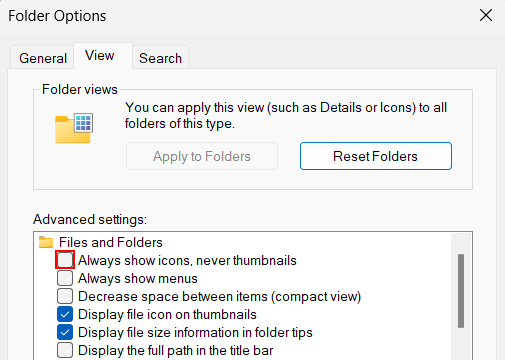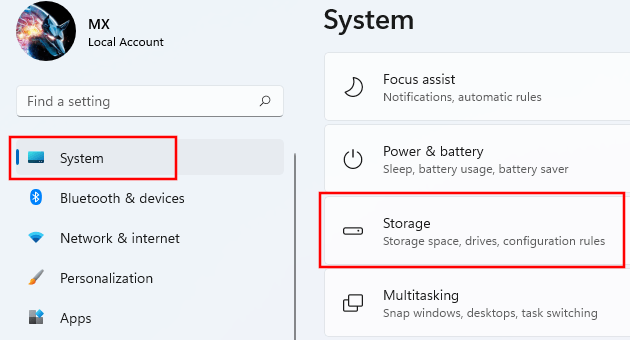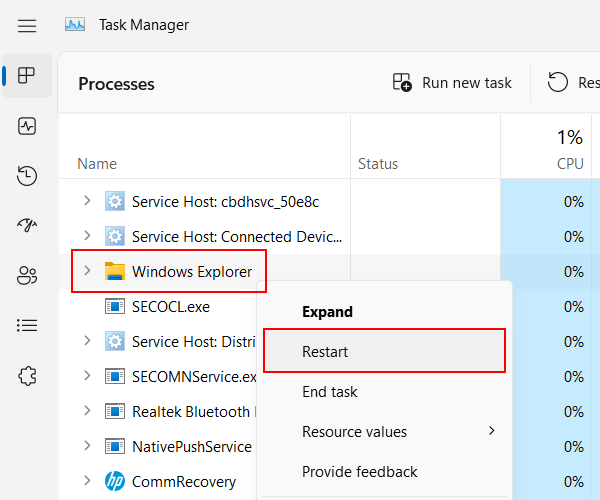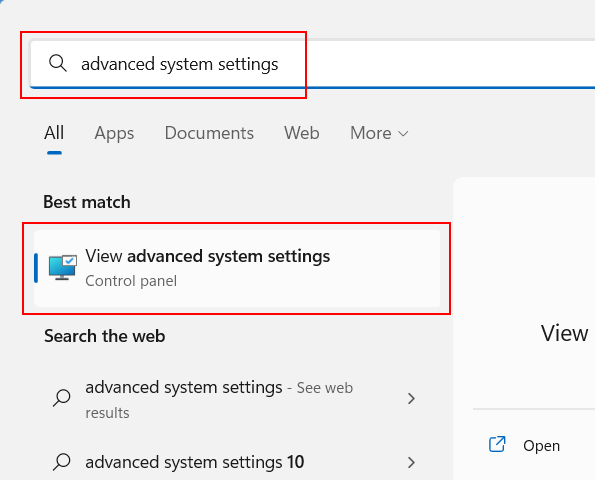Fix: Thumbnails not showing in Windows 10 or 11 File Explorer
Are thumbnails for images and videos not showing in Windows 10 or 11 File Explorer? Here are a few solutions you can try to fix the problem.
When you open a folder with photos or video files in Windows 10 or 11 File Explorer, you will usually see thumbnails (reduced-size versions of images or videos).
Thumbnails will appear for almost all video formats (e.g., MP4, AVI, MKV, WMV, FLV, MPG, and MOV) and image formats (e.g., JPG (JPEG), PNG, GIF, and PNG).
If you only see default icons (e.g., VLC icons) and no thumbnail previews, you can try the solutions on this page to fix the problem.
Fix: Thumbnails not showing in Windows 10 File Explorer
Solution 1: Check the 'View' mode in File Explorer
First, you will have to make sure that the right 'View' mode is selected for the folder that contains your photos or videos.
The following 'View' modes show thumbnail previews for images and videos:
- Extra large icons
- Large icons
- Medium icons
- Tiles
- Content
Steps
-
Open File Explorer.

- Open the folder that contains your pictures or video files.
-
Click on View in the top left menu.

-
Click on one of the following options: Extra large icons, Large icons, Medium icons, Tiles, or Content.

Solution 2: Check a 'Folder Options' setting
-
Open File Explorer.

- Click on File located in the top left corner.
-
Click on Change folder and search options.

- In the 'Folder Options' window, you click on View.
-
Make sure the Always show icons, Never thumbnails option is unchecked.

- If the option was checked and you unchecked it, click on Apply in the bottom right corner of the 'Folder Options' window.
- Click on OK.
Solution 3: Restore File Explorer settings to default
-
Open File Explorer.

- Click on File located at the top left.
-
Click on Change folder and search options.

-
In the 'Folder Options' window, you click on Restore Defaults.

- Click on the View tab.
-
Click on Restore Defaults.

- Click on Apply below Restore Defaults.
- Click on OK.
Solution 4: Clear thumbnail cache
- Click on the Windows start menu button or search icon or search bar.
- Type disk cleanup.
- Click on Disk Cleanup when it appears in the search results.
- Make sure the system drive is selected. The system drive is the drive where Windows 10 is installed. Usually, it's the C drive.
-
Click on OK.

-
Check the checkbox next to Thumbnails.

- Click on OK.
- In the next window, you click on Delete Files.
Disk cleanup will now delete unnecessary files.
Windows File Explorer will automatically generate new thumbnails when required.
Solution 5: Make sure there's enough space on your system drive
When your system drive (the drive where Windows 10 is installed) becomes full, Windows might stop generating thumbnails.
Check the disk space of your system drive (usually the (C:) drive). If there's not enough disk space left on your system drive, you'll have to delete or move files from your system drive.
When your system drive reaches a minimum of 1 GB of remaining disk space, the thumbnails will reappear.
Solution 6: Restart the 'Windows Explorer' process
- Right-click on the Windows start menu button or taskbar.
- Click on Task Manager.
- In the 'Processes' tab, you right click on Windows Explorer.
-
Click on Restart.

- Close Task Manager.
If this solution doesn't work the first time, then try it at least three times.
Solution 7: Windows Performance Options 1
- Click on the Windows start menu button or search icon or search bar.
- Type advanced system settings.
- Click on View advanced system settings when it appears in the search results.
-
In the 'Performance' section, you click on Settings.

-
In the 'Performance Options' window, you make sure the checkbox next to Show thumbnails instead of icons is checked.

- Click on Apply in the bottom right corner of the 'Performance Options' window.
- Click on OK.
Solution 8: Windows Performance Options 2
- Click on the Windows start menu button or search icon or search bar.
- Type advanced system settings.
- Click on View advanced system settings when it appears in the search results.
-
In the 'Performance' section, you click on Settings.

-
In the 'Performance Options' window, you check the checkbox next to Save taskbar thumbnail previews.

- Click on Apply in the bottom right corner of the 'Performance Options' window.
- Click on OK.
Solution 9: System File Checker
To fix problems on Windows 10, you can use the DISM and SFC tools to replace missing and corrupted system files.
System File Checker (SFC) is a Windows utility that allows users to scan for corruptions in Windows system files and restore corrupted files.
-
Press the Windows
 + X keys on your keyboard to open the WinX menu.
+ X keys on your keyboard to open the WinX menu.
- In the WinX menu, you click on Command Prompt (Admin).
- When the User Account Control (UAC) window appears, you click Yes. Depending on your settings, you might need to enter your administrator password first and then click Yes.
-
In the Command Prompt window, you type
sfc /scannow.
- Press the Enter key on your keyboard.
- The System File Checker tool will scan all protected system files, and replace corrupted files with a cached copy. This process may take a while. Wait for the process to finish.
- When the System File Checker is finished, you close the Command Prompt window.
- Restart your PC.
Note: If the System File Checker tool is unable to fix corrupt files, go to the following page: How to fix 'SFC unable to fix corrupt files' in Windows 10 and 11.
Solution 10: DISM
DISM (Deployment Image Servicing and Management) is a tool for troubleshooting and repairing Windows 10 system images.
-
Press the Windows
 + X keys on your keyboard to open the WinX menu.
+ X keys on your keyboard to open the WinX menu.
- In the WinX menu, you click on Command Prompt (Admin).
- If the 'User Account Control' window appears, you click Yes. Depending on your settings, you may need to enter your administrator password first and then click Yes.
-
In the Command Prompt window, you type the following command.
DISM /Online /Cleanup-Image /CheckHealth - Press the Enter key on your keyboard.
- Wait for the command to finish.
-
Type the following command.
DISM /Online /Cleanup-Image /ScanHealth - Press the Enter key on your keyboard.
- Wait for the command to finish.
-
Type the following command.
DISM /Online /Cleanup-Image /RestoreHealth - Press the Enter key on your keyboard.
- When the DISM scan is complete, you close the Command Prompt window.
- Restart your PC.
Solution 11: Use Icaros (free tool)
Icaros is a free program that can generate thumbnails for almost all video and image file types.
You can download Icaros from majorgeeks.com.
- Open Icaros.
-
Make sure that THUMBNAILING is activated. If it's deactivated, click on it to activate it.

-
Select an option (e.g., MOST KNOWN) at THUMBNAIL FILETYPES and PRESET.

- Close Icaros.
Fix: Thumbnails not showing in Windows 11 File Explorer
Solution 1: Check the 'View' mode in File Explorer
First, you will have to make sure that the right 'View' mode is selected for the folder that contains your photos or videos.
The following 'View' modes show thumbnail previews for images and videos:
- Extra large icons
- Large icons
- Medium icons
- Tiles
- Content
Steps
-
Open File Explorer.

- Open the folder that contains your images or videos.
- Click on View in the top menu.
-
Click on one of the following options: Extra large icons, Large icons, Medium icons, Tiles, or Content.

Solution 2: Check a 'Folder Options' setting
-
Open File Explorer.

- Click on the three-dot icon located in the top menu.
-
Click on Options.

- In the 'Folder Options' window, you click on the View tab.
-
Make sure the Always show icons, Never thumbnails option is unchecked.

- If the option was checked and you unchecked it, click on Apply in the bottom right corner of the 'Folder Options' window.
- Click on OK.
Solution 3: Restore File Explorer settings to default
-
Open File Explorer.

- Click on the three-dot icon located in the top menu.
-
Click on Options.

-
In the 'Folder Options' window, you click on Restore Defaults.

- Click on Apply located below Restore Defaults.
- Click on OK.
Solution 4: Clear thumbnail cache
- Right-click on the Windows start menu button.
- Click on Settings.
- In the 'Settings' window, you click on System located in the left menu.
-
Click on Storage.

- Click on Temporary files, and it will search for temporary files you can delete.
-
Once the scan is complete, check the checkbox next to Thumbnails.

- You can also check other files you want to delete.
-
Click on Remove files.

- In the next window, you click on Continue.
Windows will now delete thumbnails and all other selected files.
This process may take a while, depending on what other files you've selected. Sometimes, it may seem like nothing is happening, but you must let the process complete.
Windows will automatically generate new thumbnails when required.
Solution 5: Make sure there's enough space on your system drive
When your system drive (the drive where Windows 11 is installed) becomes full, Windows might stop generating thumbnails.
Check the disk space of your system drive (usually the (C:) drive). If there's not enough disk space left on your system drive, you'll have to delete or move files from your system drive.
When your system drive reaches a minimum of 1 GB of remaining disk space, the thumbnails will reappear.
Solution 6: Restart the 'Windows Explorer' process
- Right-click on the Windows start menu button or taskbar.
- Click Task Manager.
- If the 'User Account Control' window appears, you click Yes. Depending on your settings, you might need to enter your administrator password first and then click Yes.
- In the 'Processes' tab of the 'Task Manager' window, you right-click on Windows Explorer.
-
Click on Restart.

- Close Task Manager.
If this solution doesn't work the first time, then try it at least three times.
Solution 7: Windows Performance Options 1
-
Click on the Windows start menu button or search icon located in the taskbar.

- Type advanced system settings.
-
Click on View advanced system settings when it appears in the search results.

-
In the 'Performance' section of the 'System Properties' window, you click on Settings.

-
In the 'Performance Options' window, you make sure the checkbox next to Show thumbnails instead of icons is checked.

- Click on Apply in the bottom right corner of the 'Performance Options' window.
- Click on OK.
Solution 8: Windows Performance Options 2
-
Click on the Windows start menu button or search icon located in the taskbar.

- Type advanced system settings.
-
Click on View advanced system settings when it appears in the search results.

-
In the 'Performance' section of the 'System Properties' window, you click on Settings.

-
In the 'Performance Options' window, you check the checkbox next to Save taskbar thumbnail previews.

- Click on Apply in the bottom right corner of the 'Performance Options' window.
- Click on OK.
Solution 9: System File Checker
To fix problems on Windows 11, you can use the System File Checker tool to replace missing and corrupted system files.
System File Checker (SFC) is a Windows utility that allows users to scan for corruptions in Windows system files and restore corrupted files.
-
Press the Windows
 + X keys on your keyboard to open the WinX menu.
+ X keys on your keyboard to open the WinX menu.
-
In the WinX menu, you click on Terminal (Admin).

- When the User Account Control (UAC) window appears, you click Yes. Depending on your settings, you might need to enter your administrator password first and then click Yes.
-
In the Terminal window, you type
sfc /scannow.
- Press the Enter key on your keyboard.
- The System File Checker tool will scan all protected system files, and replace corrupted files with a cached copy. This process may take a while. Wait for the process to finish.
- When the System File Checker is finished, you close the Terminal window.
- Restart your PC.
Note: If the System File Checker tool is unable to fix corrupt files, go to the following page: How to fix 'SFC unable to fix corrupt files' in Windows 10 and 11.
Solution 10: DISM
DISM (Deployment Image Servicing and Management) is a tool for troubleshooting and repairing Windows 11 system images.
-
Press the Windows
 + X keys on your keyboard to open the WinX menu.
+ X keys on your keyboard to open the WinX menu.
-
In the WinX menu, you click on Terminal (Admin).

- When the User Account Control (UAC) window appears, you click Yes. Depending on your settings, you might need to enter your administrator password first and then click Yes.
-
In the Terminal window, you type the following command.
DISM /Online /Cleanup-Image /CheckHealth - Press the Enter key on your keyboard.
- Wait for the command to finish.
-
Type the following command.
DISM /Online /Cleanup-Image /ScanHealth - Press the Enter key on your keyboard.
- Wait for the command to finish.
-
Type the following command.
DISM /Online /Cleanup-Image /RestoreHealth - Press the Enter key on your keyboard.
- After the DISM scan is complete, you close the Terminal window.
- Restart your PC.
Solution 11: Use Icaros (free tool)
Icaros is a free program that can generate thumbnails for almost all video and image file types.
You can download Icaros from majorgeeks.com.
- Open Icaros.
-
Make sure that THUMBNAILING is activated. If it's deactivated, click on it to activate it.

-
Select an option (e.g., MOST KNOWN) at THUMBNAIL FILETYPES and PRESET.

- Close Icaros.
Related: